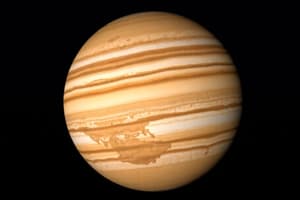Podcast
Questions and Answers
What gives Neptune its blue color?
What gives Neptune its blue color?
- Hydrogen gas
- Water vapor
- Methane gas (correct)
- Ammonia clouds
What phenomenon was named the "Great Dark Spot" on Neptune?
What phenomenon was named the "Great Dark Spot" on Neptune?
- A ring arc
- A moon's orbit
- An icy geyser
- A large storm (correct)
How long does it take for Neptune to complete one orbit around the Sun?
How long does it take for Neptune to complete one orbit around the Sun?
- 165 Earth years (correct)
- 365 Earth years
- 84 Earth years
- 225 Earth years
What is unique about Neptune's largest moon, Triton?
What is unique about Neptune's largest moon, Triton?
What materials primarily compose Neptune's atmosphere?
What materials primarily compose Neptune's atmosphere?
What was discovered about Triton's atmosphere in recent observations?
What was discovered about Triton's atmosphere in recent observations?
What is the surface temperature of Triton approximately?
What is the surface temperature of Triton approximately?
What type of storm is prevalent on Neptune despite its distance from the Sun?
What type of storm is prevalent on Neptune despite its distance from the Sun?
Flashcards
Neptune's distance from the sun
Neptune's distance from the sun
Neptune is more than 30 times farther from the sun than Earth.
Neptune's composition
Neptune's composition
Neptune is a mixture of water, ammonia, and methane over an Earth-sized solid center, with an atmosphere of hydrogen, helium, and methane.
Neptune's color
Neptune's color
Neptune's blue color is caused by methane in its atmosphere.
Neptune's winds
Neptune's winds
Signup and view all the flashcards
Neptune's Great Dark Spot
Neptune's Great Dark Spot
Signup and view all the flashcards
Triton's orbit
Triton's orbit
Signup and view all the flashcards
Triton's temperature
Triton's temperature
Signup and view all the flashcards
Neptune's discovery year
Neptune's discovery year
Signup and view all the flashcards
Study Notes
Neptune Overview
- Neptune is the farthest planet from the Sun in our solar system
- It is extremely cold and windy, much farther than Earth from the Sun
- Neptune is similar to Uranus
- Neptune is made of a thick gas of water, ammonia, and methane, with a solid center the size of Earth
- It takes sunlight 4 hours to travel from the Sun to Neptune at that distance
- Neptune has a blue color due to methane in its atmosphere
- Neptune has the strongest winds in our solar system
- The winds can be up to three times stronger than Jupiter's and nine times stronger than Earth's
- A large, oval-shaped storm called the "Great Dark Spot" was observed in Neptune's southern hemisphere but has since disappeared
Neptune's Orbit and Rotation
- It takes 165 Earth years for Neptune to orbit the Sun
- One day on Neptune is equivalent to 16 Earth hours (one complete rotation)
- Neptune was discovered in 1846
Neptune's Rings and Moons
- Neptune has at least 6 rings, plus 4 ring arcs that are difficult to see.
- Neptune has 14 moons
- Triton, Neptune's largest moon, orbits backward (retrograde) unlike other moons, suggesting it may have been captured
- Triton has a thin atmosphere that is getting warmer, with geysers erupting icy material above its surface that are more than 8 km high
Neptune's Exploration
- Voyager 2 visited Neptune in 1989 and gathered information about its rings, moons, and magnetic field.
- Voyager 2 found 10 new moons, 2 new rings and a stronger magnetic field than Saturn's
- Voyager 2 traveled 3 billion kilometers in nine years, which took six hours to observe Uranus and its rings and moons
- New technologies like the Hubble Space Telescope and ground-based telescopes have further enhanced our understanding of Uranus' attributes.
- New Horizons passed the orbit of Uranus in 2011
Studying That Suits You
Use AI to generate personalized quizzes and flashcards to suit your learning preferences.




